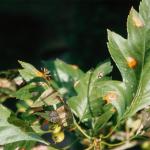Cedar-Hawthorn Rust
The fungus Gymnosporangium globosum causes cedar hawthorn rust.
Host Plants
The fungus spends part of its annual life cycle in apple and crabapple (Malus species), hawthorn (Crataegus species), and occasionally on pear (Pyrus species) and serviceberry (Amelanchier species). The other part of its life cycle is on juniper, primarily eastern red cedar (Juniperus virginiana) and Rocky Mountain juniper Juniperus scopularum. In addition, several other Juniperus species including common (J. communis) and prostrate (J. horizontalis) are also susceptible to infection.
Description
The most frequently noted symptoms are bright yellow spots on hawthorn, apple, and crabapple leaves in the summer.
Heavy leaf infections cause early leaf loss. In addition, cedar hawthorn rust occasionally infects fruit and green shoots, which distorts growth. Cedar hawthorn rust infected juniper foliage develops swollen spherical growths (galls). The galls grow slowly, are red-brown when young, and become 1/8-1/2 inch in diameter. During prolonged wet periods in the spring, the juniper galls erupt with chestnut brown gelatinous cones.
Disease Cycle
In the spring, gelatinous cones erupt out of mature galls on infected junipers and release spores infectious to nearby rosaceous hosts. The spores drift through the air chiefly at night and early morning. If they land on hawthorn leaves, green shoots, and fruit that remain wet for 4-6 hour periods, the spores germinate and penetrate them. After several weeks, yellow spots develop on the infected hawthorn leaves. By mid-summer the spots appear slightly raised and light-colored "bristles" (actually fungal fruiting structures) are visible on the underside of the leaf spots. These fruiting structures release spores and the wind carries them to nearby juniper (cedar) trees. Infected juniper foliage shows no symptoms of infection initially. Inspect them closely the spring following infection for small, red-brown swellings (immature galls). The galls reach full size by the end of the next growing season but do not mature and develop gelatinous cones until the following spring (20+ months after infection).
Management Strategies
It is difficult to avoid growing susceptible juniper close to hawthorn, crabapple and apple. Most spores produced in the juniper galls infect hawthorn trees within a few hundred yards of the juniper host, however spores can infect a fair number of hawthorn as far as 15 miles away. If replacement is an option, grow cedar hawthorn rust resistant varieties of Crataegus. Resistant to very resistant species and varieties of hawthorn include: English (C. laevigata), cockspur (C. crusgalli), Washington (C. phaenopyrum), green (C. viridis 'Winter King'), Copenhagen (C. intricata), and frosted hawthorn (C. pruinosa). Apply fungicides to susceptible, high value hawthorn during the period when juniper galls are producing gelatinous cones. Specifically, begin spraying when buds just start to break open and repeat the sprays at labeled intervals until a week after petal fall, or dry conditions prevail. Do not apply fungicides to control cedar hawthorn rust on juniper because it rarely causes noticeable damage to this host. Remove dormant galls from juniper during the fall, winter, and early spring before the chestnut brown gelatinous cones begin to erupt from galls.
Written by: Dan Gillman
Revised: 09/2011
Photo: C. L. Ash, Diseases of Woody Ornamentals and Trees. APS Press.
